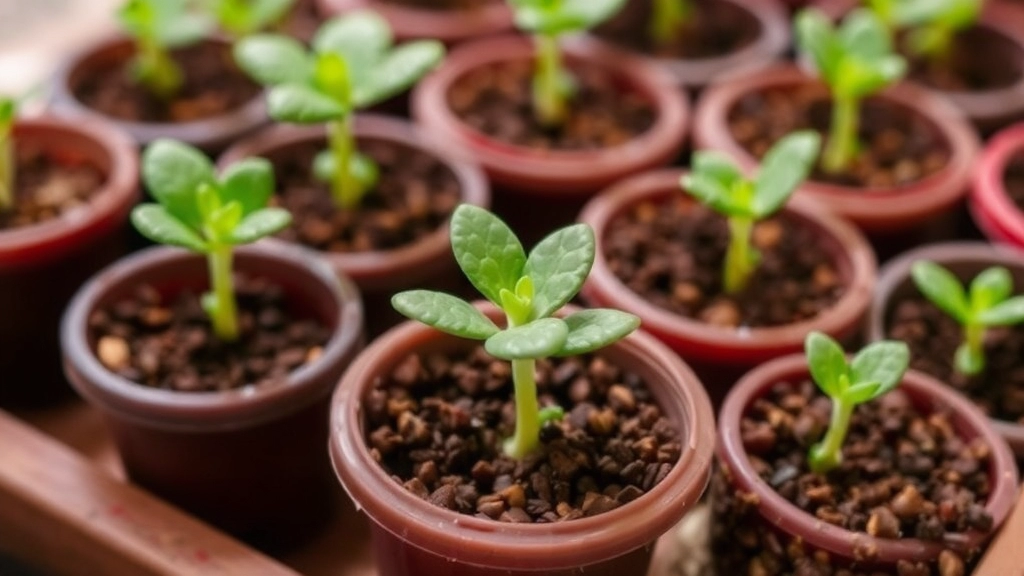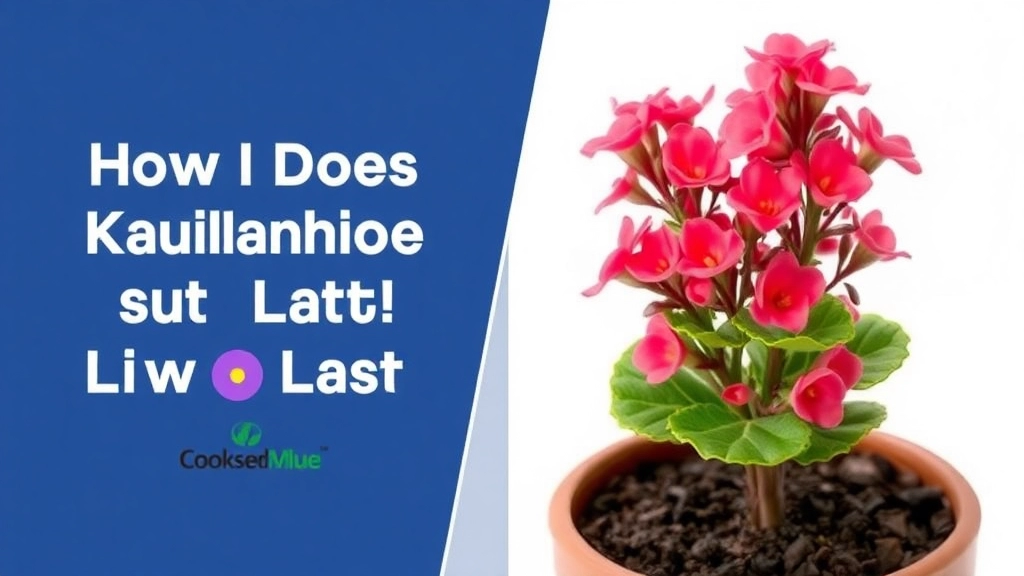Understanding the Lifespan of Kalanchoe
Ever wondered, “How long does Kalanchoe last?” You’re not alone. As a succulent lover, I’ve often found myself curious about the lifespan of these vibrant plants. Typically, a well-cared-for Kalanchoe can last several years, bringing joy with its colourful blooms.
Key Factors for Longevity
Understanding the longevity of Kalanchoe involves a few key factors like proper watering, sunlight, and temperature. By ensuring your plant gets the right care, you can enjoy its beauty for a long time. Let’s dive into the essentials to keep your Kalanchoe thriving.
Lifespan of Kalanchoe Plants
When considering the lifespan of Kalanchoe plants, many people wonder how long these vibrant succulents can thrive in their homes.
Typically, Kalanchoe plants can live anywhere from 3 to 10 years, depending on various factors such as care, environment, and species.
These hardy plants are known for their resilience, but understanding their lifespan can help you provide the best care possible.
Key Lifespan Insights
- Species Variability: Different Kalanchoe species may have varying lifespans. For instance, Kalanchoe blossfeldiana is often seen as a short-term ornamental plant, while others can last much longer with the right care. Learn more in our Ultimate Guide to Kalanchoe Blossfeldiana Hybrid Care.
- Care Practices: The way you care for your Kalanchoe plays a crucial role in its longevity. Proper watering, feeding, and light conditions can significantly extend its life. For detailed care tips, check out our guide on Best Practices for Indoor and Outdoor Kalanchoe Care.
- Environmental Factors: Factors such as temperature, humidity, and pot size also influence how long your Kalanchoe will thrive. A stable environment can lead to a longer lifespan.
Factors Affecting Kalanchoe Longevity
So, you’ve got your Kalanchoe and you want it to thrive for ages, right?
Well, there are a few key factors that can really impact how long your plant sticks around. Let’s dive into those!
1. Light Conditions
- Bright Indirect Light: Place it near a window where it can soak up that sunshine without getting scorched.
- Avoid Direct Sun: Too much direct sun can burn those lovely leaves.
2. Watering Habits
- Drench and Dry: Water your Kalanchoe thoroughly, but let the soil dry out between waterings.
- Signs of Thirst: If the leaves start to wrinkle, it’s time for a drink.
3. Temperature
- Ideal Range: They thrive between 15°C to 25°C.
- Watch for Drafts: Keep them away from chilly drafts or heat sources.
4. Soil Quality
- Well-Draining Mix: Use a cactus or succulent mix to ensure good drainage.
- Nutrient Boost: A little fertiliser during the growing season can help, but don’t overdo it.
5. Pest Management
- Regular Checks: Keep an eye out for pests like mealybugs or aphids.
- Natural Remedies: A gentle soap spray can help keep them at bay.
6. Repotting Needs
- Every 1-2 Years: Repotting helps refresh the soil and gives the roots room to grow.
- Choose the Right Pot: Make sure it has drainage holes to prevent waterlogging.
Seasonal Care Tips for Kalanchoe
As we delve deeper into maintaining the health of your Kalanchoe, understanding seasonal care becomes essential. The changing seasons bring different challenges and opportunities for your plant.
Common Issues and Solutions

As we delve deeper into the care of Kalanchoe plants, it’s crucial to address the common issues that can arise, impacting their health and longevity. Many plant enthusiasts often find themselves facing challenges that can be easily remedied with the right knowledge.
1. Overwatering
Issue:
Kalanchoe plants are succulents, which means they thrive in dry conditions. Overwatering can lead to root rot, a common concern for many gardeners.
Solution:
- Ensure pots have drainage holes.
- Water only when the top inch of soil is dry.
- Use a well-draining potting mix.
2. Underwatering
Issue:
Conversely, underwatering can cause the leaves to shrivel and the plant to look lifeless.
Solution:
- Check soil moisture regularly.
- Water thoroughly until excess drains out.
- Increase watering frequency during the growing season.
3. Pests
Issue:
Kalanchoe plants can attract pests like aphids and mealybugs, which can stunt growth and affect appearance.
Solution:
- Inspect plants regularly for signs of pests.
- Use insecticidal soap or neem oil for treatment.
- Introduce beneficial insects like ladybugs for natural pest control.
4. Leaf Discoloration
Issue:
Yellowing leaves can indicate various issues, from nutrient deficiencies to improper lighting.
Solution:
- Assess light conditions; Kalanchoe prefers bright, indirect sunlight.
- Fertilize with a balanced succulent fertiliser during the growing season.
- Remove any dead or yellowing leaves to promote new growth.
5. Flowering Problems
Issue:
Sometimes, Kalanchoe may not bloom as expected, leaving owners disappointed.
Solution:
- Ensure the plant receives adequate light.
- Provide a period of darkness (about 14 hours) to encourage blooming.
- Avoid over-fertilising, which can lead to lush foliage at the expense of flowers.
Best Practices for Kalanchoe Maintenance
Maintaining a healthy Kalanchoe can sometimes feel overwhelming, especially for those new to succulent care. However, with the right practices, you can ensure your plant thrives for years to come.
Watering Wisely
One of the most common mistakes is overwatering. Kalanchoes prefer to dry out between waterings. Here are some tips:
- Check the soil: Stick your finger about an inch into the soil. If it feels dry, it’s time to water.
- Water thoroughly: When you do water, make sure to soak the soil completely, allowing excess water to drain out.
- Adjust for seasons: In winter, reduce watering frequency as the plant enters dormancy.
Optimal Lighting Conditions
Kalanchoes thrive in bright, indirect sunlight. Here’s how to ensure they get enough light:
- Placement: Position your plant near a window that receives ample light but avoid direct sun, which can scorch the leaves.
- Rotate regularly: Turn your plant every few weeks to ensure even growth.
Fertilisation
Feeding your Kalanchoe is essential for its growth. Consider these practices:
- Use a balanced fertiliser: Opt for a diluted, balanced fertiliser during the growing season (spring and summer).
- Frequency: Fertilise every four to six weeks for optimal results.
Pruning and Deadheading
Regular maintenance can encourage new growth:
- Remove dead leaves: Snip off any yellow or dead leaves to prevent disease.
- Deadhead flowers: After blooms fade, remove spent flowers to promote further flowering.
Pest Management
Keeping pests at bay is crucial for Kalanchoe health. Here’s what you can do:
- Inspect regularly: Check for signs of pests like mealybugs or aphids.
- Natural remedies: Use insecticidal soap or neem oil if you spot any infestations.
For more detailed care instructions, you might find our Complete Care Guide for Pink Butterflies Kalanchoe helpful. Additionally, if you’re interested in the medicinal benefits of Kalanchoe, check out our article on Kalanchoe Pinnata’s Medicinal Uses and Health Benefits.
Propagation Techniques to Extend Lifespan

So, you’re keen to keep your Kalanchoe thriving for as long as possible? One of the best ways to do this is through propagation. Not only does it help you grow more plants, but it can also rejuvenate your existing ones.
Why Propagation?
Propagation allows you to create new plants from your current ones. This can extend the lifespan of your Kalanchoe by ensuring you have healthy, young plants to replace any that may be struggling. Plus, it’s a rewarding experience!
Simple Propagation Methods:
- Leaf Cuttings:
- Pick a healthy leaf from your Kalanchoe.
- Let it dry out for a day or two to form a callus.
- Place it in well-draining soil and water lightly.
- New roots should sprout in a few weeks!
- Stem Cuttings:
- Cut a healthy stem about 4-6 inches long.
- Remove the lower leaves and let it dry for a day.
- Stick the cutting in soil, water it, and watch it grow!
- Offsets:
- Some Kalanchoe varieties produce offsets (baby plants).
- Gently separate these from the main plant.
- Plant them in their own pots with fresh soil.
Tips for Successful Propagation:
- Always use clean, sharp tools to avoid infection.
- Keep the new plants in a warm, bright spot, but out of direct sunlight.
- Water sparingly until you see new growth.
By mastering these techniques, you not only get more plants but also keep the spirit of your Kalanchoe alive and kicking.
Signs of a Healthy Kalanchoe
As we delve into the signs of a healthy Kalanchoe, it’s essential to understand that these indicators reflect the overall care and conditions your plant experiences. Recognising these signs can help ensure your Kalanchoe thrives for years to come.
Key Indicators of a Healthy Kalanchoe:
- Vibrant Leaves: Look for bright green, plump leaves. A healthy Kalanchoe will have leaves that are firm and free from discoloration or spots.
- Robust Growth: New growth is a positive sign. If your plant is producing fresh leaves or flowers, it indicates that it is thriving.
- Sturdy Stems: The stems should be thick and upright. Weak or leggy stems may suggest inadequate light or overwatering.
- Blooming Flowers: If your Kalanchoe is in bloom, it’s a good sign of health. Healthy flowers are vibrant and open, adding beauty to your plant.
- Minimal Pests: Regularly check for pests. A healthy plant will have minimal to no signs of infestations.
- Absence of Wilting: Leaves that are not wilting or drooping are a clear indication of proper watering and care.
By keeping an eye on these signs, you can ensure that your Kalanchoe remains a vibrant part of your home or garden. For more detailed care tips, check out our Complete Guide to Kalanchoe Plant Care. If you notice issues like leggy stems, our guide on How to Fix a Leggy Kalanchoe can provide effective solutions.
FAQs: How Long Does Kalanchoe Last?
What factors affect the longevity of a Kalanchoe plant?
Several key factors impact the lifespan of a Kalanchoe plant, including light conditions, watering habits, temperature, soil quality, pest management, and repotting needs. Ensuring optimal conditions in these areas can help your Kalanchoe thrive for a long time.
What kind of light does a Kalanchoe need?
Kalanchoe plants prefer bright, indirect light. Place them near a window where they can soak up sunlight without getting scorched. Avoid direct sunlight as it can burn the leaves.
How should I water my Kalanchoe?
Use the drench and dry method: water the plant thoroughly and then allow the soil to dry out between waterings. If the leaves start to wrinkle, it’s time to water the plant.
What is the ideal temperature range for Kalanchoe plants?
Kalanchoe plants thrive in temperatures between 15°C to 25°C. Keep them away from chilly drafts or heat sources to maintain their health.
What type of soil is best for Kalanchoe?
A well-draining cactus or succulent mix is ideal for Kalanchoe plants. Adding a little fertilizer during the growing season can also help, but avoid over-fertilizing.
How can I manage pests on my Kalanchoe?
Regularly check your Kalanchoe for pests like mealybugs or aphids. Natural remedies such as a gentle soap spray can help keep pests at bay.
How often should I repot my Kalanchoe?
Repotting every 1-2 years helps refresh the soil and gives the roots room to grow. Make sure to choose a pot with drainage holes to prevent waterlogging.
What are common issues with Kalanchoe plants and their solutions?
Common issues include overwatering, underwatering, pests, leaf discoloration, and flowering problems. Solutions involve adjusting watering habits, checking for pests regularly, ensuring proper light conditions, and providing adequate nutrients.
How can I propagate my Kalanchoe to extend its lifespan?
Propagation can rejuvenate your Kalanchoe and create new plants. Methods include leaf cuttings, stem cuttings, and offsets. Use clean tools, keep new plants in a warm, bright spot, and water sparingly until new growth appears.
References
-
Kalanchoe Plant Care: How To Grow A Kalanchoe
-
Kalanchoe Succulent Plant Profile
-
Kalanchoe: How to Grow and Care for Kalanchoe Plants
